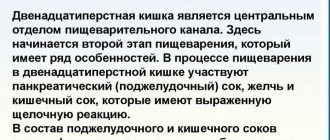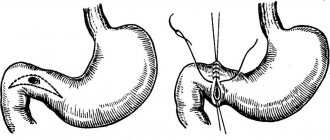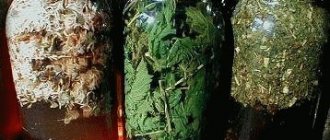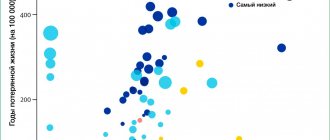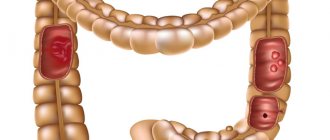Peptic ulcer disease is a group of chronic diseases that are manifested by alternating periods of exacerbation and remission. There is an inflammatory process and the formation of ulcerative defects in the mucous membrane of the stomach and/or duodenum (duodenum). As a rule, peptic ulcer disease is seasonal; the period of exacerbation of the disease is observed in the spring and autumn seasons.
Peptic ulcer disease is quite common in the modern world. In industrialized countries, 8-10% of the population suffers from this disease. In Russia, over the past 10 years, the incidence of peptic ulcer disease has increased by 38%. It is important to note that gastric ulcer is observed in the population over 40 years of age, and duodenal ulcer is most often detected before 40 years of age. As for gender, men are more often affected than women. The ratio between women and men for gastric ulcers is 1:2, and for duodenal ulcers it is 1:4.
Causes of peptic ulcer
The causative factors causing the formation of ulcers are:
- Helicobacter pylori infection
- thermal, mechanical, chemical “rough food”, irregular, dry food
- heredity
- smoking, drinking alcohol, various drugs
- taking ulcerogenic drugs
- stress
The occurrence of peptic ulcer is based on an imbalance of protective and damaging factors in the area of the stomach and duodenum.
Protective factors:
- mucus protective barrier
- adequate blood circulation
- regenerative ability of stomach cells
- synthesis of substances that suppress and inhibit damaging factors
Damaging factors:
- hyperproduction of hydrochloric acid and the enzyme pepsin
- infection of the mucous membrane with Helicobacter pylori
- impact on the gastric mucosa and duodenum of bile, pancreatic juice
- smoking, alcohol
- some medications
- heredity
Symptomatic acute ulcers
A characteristic manifestation of an acute ulcer is necrosis and destruction of the epithelium of the mucous membrane, submucosal, and sometimes muscular layers. Healing of such an ulcer occurs by tissue regeneration, and not by replacing damaged layers with connective tissue, and scar formation does not occur.
Symptomatic ulcers occur against the background of impaired blood microcirculation in the mucous membrane, or, for example, as a side effect of taking nonsteroidal anti-inflammatory drugs, hormones, and salicylates.
Symptoms of peptic ulcer
Pain syndrome
- Ulcer of the body of the stomach - pain appears 1/2 hour-1 hour after eating food, lasts 1-2 hours, and then subsides. Pain occurs in the epigastric (epigastric) region and on the left.
- Ulcers of the antrum, pylorus, and duodenal bulb - hunger pain, night pain, and late pain appear. Late pain appears 2-3 hours after eating. “Hunger” pains occur on an empty stomach and subside after eating a small amount of food. Night pain occurs in the early morning hours (2-4 hours). More often, pain occurs in the epigastric (epigastric) region, on the right.
- Ulcers of the cardial part of the stomach - pain occurs 10-15 minutes or immediately after eating and disturbs directly in the epigastric region.
Stomach dyspepsia
- For stomach ulcers: heartburn, sour belching, nausea, refusal to eat.
- For duodenal ulcers (DU): belching, heartburn, nausea less frequently, sour vomiting.
Intestinal dyspepsia
- for stomach ulcers: tendency to diarrhea
- with duodenal ulcers: tendency to constipation
Astheno-vegetative manifestations
- Appears in any localization of ulcers: decreased performance, weakness, irritability, fatigue.
Indications for stomach ulcers
Timely treatment ensures effective relief from the disease. Main indications for the treatment of ulcers:
- stop drinking alcohol, eat regularly and properly, exclude fried, fatty, spicy and salty foods;
- prevention of Helicobacter infection - for this it is recommended to follow standard recommendations;
- follow hygiene rules (wash hands before eating);
- wash food before eating;
- use fresh food and throw away spoiled food;
- Wash the dishes well, rinse off any remaining detergent.
Lifestyle in the presence of an ulcer is mainly determined by proper dietary nutrition, which is based on the following provisions:
- frequent and small meals (up to 5-6 times a day), while overeating must be avoided;
- eat enveloping foods, such as oatmeal;
- limit the use of extractive substances;
- give up animal fats;
- eat the portion of foods prescribed by your doctor or nutritionist that contain polyunsaturated fatty acids, which promote rapid healing of ulcers in the stomach and duodenum.
Peptic ulcer risk test
Please take a few minutes to answer the questions below. Try to be honest. Answer the questions: “yes” or “no”.
- Do you and/or your relatives have gastrointestinal diseases?
- Have any of your relatives been diagnosed with Helicobacter pylori?
- Do you smoke?
- Do you follow a diet?
- Are you worried about heartburn, sour belching, aversion to food?
- Have you noticed a decrease in body weight recently?
- Do you have any discomfort or pain in your stomach?
- Have you ever noticed that you wake up at night because your stomach hurts?
- Do you have blood type I?
- Do you often take painkillers?
- Are you often in stressful situations?
- Do you often visit public eating places (fast food, canteen, cafe, restaurant)?
Test results: If you answered “YES” to at least 2-3 questions, you are at risk of developing peptic ulcers. If you want to prevent the progression of the disease and reduce the risk of complications and disability, you should consult a gastroenterologist. Remember that peptic ulcer disease can be asymptomatic, both in you and in your loved ones. Listen to your body, try to analyze your life, habits, nutrition, as well as the level of health in your family. A specialist from the EXPERT Clinic will be able to answer any questions you may have.
Diagnosis of peptic ulcer
At the first stage of diagnosis, the doctor collects complaints and conducts a thorough objective examination. Then, taking into account all the risks of the disease and concomitant pathologies, the doctor draws up an individual diagnostic plan, which includes laboratory and instrumental examination methods. Today, there are many biochemical indicators that help not only in diagnosing diseases of the gastrointestinal tract, but also in the timely detection of possible complications.
You can also start your examination with a basic screening for stomach diseases.
Diagnosis of perforated ulcer
To diagnose a perforated gastric or duodenal ulcer, imaging methods are used:
- ultrasound examination of the abdominal cavity (diagnostic accuracy of ultrasound is estimated to be about 80.0%),
- X-ray of the abdominal cavity (diagnostic accuracy about 80%),
- computed tomography (diagnostic accuracy of CT for perforated ulcers is 98%),
- fibrogastroduodenoscopy.
These examination methods make it possible to register the characteristic signs of a perforated ulcer: the presence and localization of an ulcer, free gas in the abdominal cavity, free fluid in the abdominal cavity, perforated hole.
The presence of air or large amounts of fluid usually indicates perforation. However, in 30% of cases of perforated gastric or duodenal ulcer, X-rays do not detect free fluid or air in the abdominal cavity. In these cases, a computed tomography (CT) scan of the abdomen may be performed.
Ultrasound of the abdominal organs is not widely used for diagnosing perforation, as it largely depends on the qualifications of the researcher. In order to study the perforation in detail and assess the presence of peritonitis (inflammation of the peritoneum), diagnostic laparoscopy (the most accurate diagnostic method) and fibrogastroduodenoscopy (diagnostic value of FGDS in determining the presence of an ulcer is 90%) are performed.
Differential diagnosis
Differential diagnosis is carried out with acute surgical diseases - appendicitis (inflammation of the cecum), cholecystitis (inflammation of the gallbladder), perforated stomach cancer, myocardial infarction (heart attack), acute intestinal obstruction, acute pleurisy (inflammation of the pleura).
Main laboratory tests used:
- Clinical blood test (complete blood count, leukocyte count, ESR);
- Biochemical blood test (including determination of amylase activity);
- Biochemical analysis of moths (urine diastasis).
- The main instrumental studies used:
- Ultrasound of the abdominal cavity (detection of free gas and liquid);
- X-ray of the abdominal cavity;
- Computed tomography of the abdominal cavity;
- Fibrogastroduodenoscopy;
- Diagnostic laparoscopy.
Forecast
In the case of timely diagnosis and adequate comprehensive treatment and the absence of complications, the prognosis is favorable.
Unfortunately, if you do not contact a gastroenterologist in a timely manner, in some cases the condition progresses with the emergence of severe life-threatening complications, leading to disability and sometimes death.
If a peptic ulcer is not detected in time, the following serious complications may develop:
- Bleeding is a fairly common complication of peptic ulcer disease (10-15%). Duodenal ulcers bleed more often than gastric ulcers. Vivid symptoms of bleeding appear during the period of exacerbation of peptic ulcer disease and are very multifaceted. Characteristic signs: bloody vomiting, black - tarry stools, constant weakness, dizziness, decreased blood pressure, increased pulse rate. It is necessary to urgently consult a doctor, as this condition is detrimental to a person’s life.
- Perforation (perforation) of the ulcer occurs in 5-20% of cases. It occurs 10-20 times more often in men than in women. The patient feels a “dagger”, sharp pain in the stomach area, takes a forced position (on the right side or back, knees brought to the stomach). The state of health gradually worsens, pale skin and mucous membranes appear, and a decrease in heart rate (bradycardia). It is also important to note that in elderly patients, perforation can occur without visible symptoms and without severe pain.
- Penetration is a condition when an ulcer spreads beyond the boundaries of the stomach and duodenum. Observed in 15% of cases. With this condition, pain occurs in the stomach when eating. Also, the pain may radiate to the back, to the right hypochondrium, and may be girdling in nature. The localization of pain is determined by the depth of the damage and the organ that is involved in the process.
- Pyloric stenosis occurs in 6-15% of patients with peptic ulcer. The clinical picture depends on the severity of the narrowing of the pylorus. Heaviness appears in the stomach after eating, vomiting, which brings relief, and sour belching occurs periodically. As the condition worsens, discomfort and a feeling of fullness in the stomach appears after eating a small amount of food, belching like a rotten egg. Only proper antiulcer treatment can improve the condition.
- Malignancy – a stomach ulcer can transform into a malignant tumor. The incidence of malignancy ranges from 1 to 38%. In people over 60 years of age, the risk of developing a peptic ulcer into gastric cancer is 1.4-2 times more likely than in young people. Clinical manifestations range from latent (hidden) course to clear symptoms of the disease. That is why, if you suspect even minimal signs of stomach disease, consult an expert doctor in order to promptly identify the risks of complications, improve your quality of life and avoid deaths.
Advantages of treatment at the clinic of JSC "Medicine"
JSC "Medicine" (clinic of academician Roitberg) is a multidisciplinary medical center that provides a range of services, including surgery and hospital stays.
Treatment at the clinic of JSC "Medicine" has the following advantages:
- license to carry out medical activities, receive patients, perform operations;
- each doctor has appropriate qualifications and significant experience in domestic and foreign clinics, and their achievements are posted on the medical center’s website;
- high-tech innovative equipment for conducting tests and examinations to establish the true causes of pathological conditions of the gastrointestinal tract;
- cooperation with insurance companies, profitable loyalty programs for corporate clients.
Doctors conduct a thorough and in-depth analysis of the patient’s health status, identify the underlying causes that led to the occurrence of stomach ulcers, and prescribe effective therapy on an outpatient or inpatient basis.
Treatment
Treatment of peptic ulcer should be comprehensive, taking into account the etiological factor of the disease. Depending on the area, depth of the lesion and associated complications, conservative (medicinal) and surgical treatment are distinguished.
Drug treatment is selected individually, based on etiological factors and concomitant pathology. When starting drug treatment for a patient, the doctor must also monitor what medications the patient uses in everyday life. Experts at the EXPERT Clinic always select effective therapy, taking into account the individual sensitivity and characteristics of each patient, and use drugs of a new level and generation.
Prevention and recommendations
It is necessary to exclude those factors that lead to the development of peptic ulcers and monitor your health in the presence of a hereditary predisposition, even if nothing bothers you.
Risk factors for developing peptic ulcers:
- Helicobacter pylori infection
- hereditary predisposition
- blood type I (0)
- bad habits (tobacco smoking, drinking alcohol and its surrogates)
- increased stomach acidity
- violation of working and rest conditions, frequent stress
- taking ulcerogenic medications (hormones, ibuprofen, Nise, Nurofen, diclofenac and others)
- non-compliance with food intake
- diseases of the gastrointestinal tract (cholecystitis, pancreatitis, gastritis, gastroduodenitis)
- chronic obstructive pulmonary disease, systemic diseases, chronic renal failure.
Factors contributing to the occurrence of the disease
Neither gastric ulcer nor duodenal ulcer can appear without the influence of additional factors. As a rule, a combination of several components leads to peptic ulcer disease, the main of which are:
- Chronic gastritis, duodenitis or gastroduodenitis.
- Love for spicy dishes, constant consumption of monotonous or rough food. Food too cold and too hot.
- Violation of proper diet. Overeating, hasty eating with poor chewing. The body does not have time to secrete the required amount of enzymes needed to digest food; food is not evacuated from the stomach on time, but is retained in it, which leads to disruption of the digestion process.
- Impaired blood microcirculation. The mucous membrane has a dense network of blood capillaries. As soon as blood circulation in them is disrupted, the mucous membrane ceases to perform its protective functions in full.
- Constant overstrain of the nervous system, emotional stress, frequent anxiety states. In this case, the body’s protective properties are not simply reduced: the person’s appetite either disappears or becomes excessive, which, again, is a violation of the normal diet. At the same time, under stress, the functions of the autonomic nervous system, which is responsible for regulating the activity of the digestive organs, are disrupted.
- Hereditary predisposition.
- Long-term use of certain medications (non-steroidal anti-inflammatory drugs, painkillers, hormonal drugs, etc.).
- Excessive coffee consumption. The harmful effect of coffee manifests itself in stimulating the formation of excess gastric juice.
- Frequent or regular consumption of alcoholic beverages. Alcohol significantly reduces the protective properties of mucous membranes.
- Smoking. Resins containing carcinogenic substances enter the gastrointestinal tract along with saliva. Smoking increases the production of gastric juice, so smoking on an empty stomach is most harmful. If you do not stop smoking during treatment, this will significantly reduce the effectiveness of the latter.
Ultrasound of the abdominal organs
- Cost: 3,800 rub.
More details
FAQ
Can peptic ulcer disease be inherited?
The ulcer itself cannot, but the risk factors for its development certainly do.
Is it possible to get a peptic ulcer?
In case of Helicobacter infection, the risk of developing peptic ulcers mainly of the duodenum and antrum is significantly higher.
Can an ulcer develop into cancer?
In the case of a long-term inflammatory process, metaplasia may develop - a change in the typical structure of the cells of the mucous membrane of the stomach and, less often, the duodenum, which significantly increases the risk of malignancy.
Can an ulcer be cured?
An uncomplicated ulcer heals itself, and the disease “peptic ulcer” and the process of ulcer formation are cured when the cause is identified (Helicobacter, bile reflux, drug-induced effects, endocrine diseases, etc.) and eliminated.
Is it possible to treat peptic ulcer without antibiotics?
If the peptic ulcer is not caused by the HP bacterium - of course, in the case of HP-associated disease - a course of antibacterial therapy is mandatory.
Classification
According to location, ulcerative defects are divided into the following types:
- gastric;
- localized in the bulb or postbulbar part of the duodenum;
- combined ulcers with simultaneous damage to the stomach and intestines.
Causes of stomach ulcers include:
- stress, including Curling's ulcer with extensive thermal burns, Cushing's ulcer with severe brain damage, post-infarction, post-traumatic and other types of ulcers;
- medicinal;
- with hyperparathyroidism;
- toxic;
- allergic.
Peptic ulcer disease is often associated with Helicobacter pylori infection, but can occur without it.
In accordance with the course of the disease, the ulcer is classified into the stages of exacerbation, scarring, and remission.
Case histories
Story No. 1
When contacting the EXPERT Clinic, patient E., 32 years old, complained of aching, cutting pain in the epigastric region 1.5 hours after eating, often at night, on an empty stomach, heartburn, sour belching, constipation, weakness, fatigue. For 5 years, in the fall, he noted the appearance of aching pain in the epigastrium and heartburn. She takes Maalox on her own. 4 years ago, 7-day eradication therapy was carried out using amoxicillin and clarithromycin. There were no post-treatment controls. From the life history: he eats irregularly, his work involves frequent business trips, he smokes. The patient was prescribed an examination (blood test; ultrasound of the abdominal cavity, FGDS + HP test, etc.) as a result of which the diagnosis was made: Peptic ulcer. Duodenal ulcer, exacerbation. HP (+). Cicatricial deformation of the duodenal bulb. Additionally, a C13-carbon breath test for HP was prescribed, which showed a high level of HP. A complex treatment was prescribed aimed at eliminating the active factor - HP. During the follow-up examination and examination, the patient did not present any complaints, and endoxoscopic examination revealed significant positive dynamics. HP - not detected. Subsequently, the patient undergoes a preventive examination once every 6 months. Over the past 2 years after treatment, no exacerbations were observed.
Story No. 2.
Patient S., 49 years old, came to the EXPERT Clinic with complaints of aching pain in the epigastric region (more on the left), after 20 minutes. after eating, sour belching, heartburn, decreasing after taking almagel. A year ago, similar complaints were noted after errors in the diet; I took Maalox and famotidine on my own. A laboratory and instrumental examination revealed an ulcer of the body of the stomach. The patient was prescribed treatment, including dietary recommendations and drug therapy aimed at protecting, restoring and reducing inflammation of the gastric mucosa. The complaints were stopped. The patient continues treatment and observation at the EXPERT Clinic.
Our services
The administration of CELT JSC regularly updates the price list posted on the clinic’s website. However, in order to avoid possible misunderstandings, we ask you to clarify the cost of services by phone: +7
| Service name | Price in rubles |
| Gastroscopy (videoesophagogastroduodenoscopy) | 6 000 |
| Breathing HELIK test (urease activity of H. Pylori) | 1 100 |
| Ultrasound of the abdominal organs (liver, gall bladder, pancreas, spleen) | 3 800 |
All services
Make an appointment through the application or by calling +7 +7 We work every day:
- Monday—Friday: 8.00—20.00
- Saturday: 8.00–18.00
- Sunday is a day off
The nearest metro and MCC stations to the clinic:
- Highway of Enthusiasts or Perovo
- Partisan
- Enthusiast Highway
Driving directions

